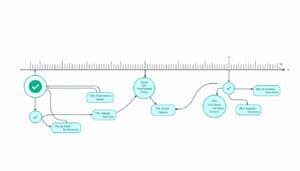In the business world, every detail matters to ensure the success of an operation.A well-designed order form is key to simplifying purchases and organizing operations.With the right tools, order management becomes a smooth and efficient process.
Today, whether managing a small business, controlling inventory, or launching a new product line, having a suitable order form is essential. The available form templates allow for quick capturing of customer information and item details while reducing errors. Thanks to these practical tools, businesses gain professionalism and speed in order management. Moreover, integration with project management software such as ProjectManager facilitates real-time tracking of project progress.
🔥 Nous recommandons Ideamap
Ideamap est l’outil idéal pour un brainstorming ou un projet collaboratif. Grâce son interface facile et à ses fonctions IA, Ideamap booste votre créativité tout en favorisant une meilleure organisation de vos idées pour atteindre vos objectifs.

what is an order form?
An order form is an essential tool for any business looking to structure its commercial transactions. Whether you are managing a small business, an inventory, or launching a new range of products, a well-designed order form facilitates purchases and keeps operations organized. By effectively capturing client information and item details, these forms reduce errors and speed up the fulfillment process.
Using a free order form template for Excel or Word not only saves time but also ensures greater professionalism in your documents. These templates are often pre-formatted to include all necessary information, such as product descriptions, quantities, prices, delivery instructions, and payment terms. By standardizing this information, businesses can ensure the consistency and accuracy of their sourcing or sales processes.
Moreover, a good order form facilitates internal tracking, budgeting, and auditing by clearly documenting each transaction. In an environment where accuracy and efficiency are paramount, having these free tools can greatly contribute to the effective management of your operations.
how to choose the right template for your needs?
Choosing the right order form template depends on several factors specific to your business. It is crucial to assess your business needs to select a template that perfectly meets your requirements. For example, if you are in the business of selling physical products, an order form for sales with sections dedicated to item descriptions, quantities, and prices will be essential. In contrast, for services, a service request form with fields to describe specific tasks and deadlines may be more appropriate.
The features offered by the template should also be considered. Some templates include advanced features such as dynamic tables, pre-filled fields, or customization options that can adapt to your internal processes. For example, an order form template for Excel can allow for easy integration with your existing databases, making inventory management and order tracking easier.
It is also important to consider ease of use and compatibility with the software you are already using. A good template should be intuitive and not require too steep a learning curve. Additionally, ensuring that the template is compatible with different versions of Word or Excel guarantees smooth use within your team.
the advantages of free templates compared to paid solutions
Opting for free order form templates offers many advantages, especially for small businesses or startups with limited budgets. One of the main advantages is the cost reduction, allowing access to professional tools without initial financial investment. These free templates often provide a solid foundation that you can customize according to your specific needs, at no extra cost.
Furthermore, free templates are generally easy to access and can be downloaded immediately, saving valuable time when setting up your business processes. They are often developed by experts and regularly updated to ensure their relevance and effectiveness. Compared to paid solutions, which may require expensive subscriptions or licenses, free templates offer an economical alternative while maintaining a high level of quality and functionality.
Moreover, using free templates promotes flexibility and adaptability. You can modify and adjust the templates based on your evolving needs without being constrained by licensing restrictions or locked features. This allows for total customization, ensuring that each order form is perfectly aligned with your internal processes and your clients’ expectations.
where to find the best free form templates?
To find the best free order form templates for Excel and Word, it’s essential to turn to reliable and reputable sources. Many specialized websites offer a wide range of templates suited to various industries and needs. For example, platforms like Tomorrow Ideation provide diverse resources that combine creativity and management, helping to overcome creative blocks while providing practical tools for order management.
The official Microsoft websites are also an excellent resource, offering many free templates that can be directly downloaded and used in Word or Excel. These templates are often created by professionals and optimized for compatibility with various versions of Microsoft software.
Additionally, online communities, forums, and blogs specializing in business management and project management regularly share free templates. Participating in these communities not only allows you to download templates but also exchange tips and tricks for their optimal use. This can be particularly useful for further customizing the templates and adapting them perfectly to your specific needs.
the different types of order forms available
There are several types of order forms, each meeting specific needs within a business. Among the most common are:
- Purchase order form: Used to formally request goods or services from suppliers. It includes key details such as item descriptions, quantities, prices, delivery instructions, and payment terms.
- Sales order form: Serves to confirm and process customer purchases. It includes information about the buyer, sold products or services, quantities, prices, total costs, delivery schedules, and payment conditions.
- Work order form: Used to request and track specific tasks or services to be performed, usually in maintenance, repair, or project-based services.
- Inventory order form: Facilitates the request, tracking, and management of stock or inventory item orders. It contains information such as item names or codes, required quantities, unit prices, and supplier details.
- Request for Quotation (RFQ) form: Used to solicit price quotes and terms from potential suppliers for specific products or services.
- Request for Information (RFI) form: Serves to collect preliminary data from suppliers, contractors, or potential service providers, usually at the beginning of the sourcing or project planning process.
Each type of order form has unique characteristics adapted to specific processes, enabling optimized management of transactions and internal operations.
how to customize your forms for greater efficiency?
Customizing your order forms is essential to make them more effective and tailored to your specific needs. Customization allows you to add or modify fields based on the information you want to collect, facilitating tracking and analysis of transactions. For example, you may add specific sections for product codes, validation steps, or comment fields to gather additional feedback from your clients.
Using tools like Excel or Word provides great flexibility to customize your forms. In Excel, you can use formulas and dynamic tables to automate certain aspects of the form, such as calculating totals or tracking inventory. In Word, you can insert interactive form fields, such as drop-down lists or checkboxes, to simplify data entry.
Moreover, customization includes adapting the layout and design to reflect your company’s identity. Using your logo, corporate colors, and consistent typography enhances the brand and conveys a sense of professionalism to your forms. A clear and well-structured layout also improves readability and makes it easier for your clients or employees to complete the forms.
integrating forms into your workflow
Integrating your order forms into your workflow is crucial for optimizing your operational processes. It ensures that the information collected from the forms is easily accessible and usable by different teams within your company. For example, a well-integrated order form can automatically feed into your inventory management system, inform your sales team, or trigger invoice generation.
For a smooth integration, it’s possible to use project management software like ProjectManager, which allows you to connect your order forms with other tools used in your business. This facilitates order tracking, resource management, and task planning while ensuring effective coordination between different teams.
Furthermore, automating certain steps in order processing can significantly enhance operational efficiency. For instance, using macros in Excel or scripts in Word can automate data sorting, sending email confirmations, or updating databases. This not only reduces the risk of human error but also frees up time for higher-value tasks.
common mistakes to avoid with order forms
Using order forms can present certain challenges if common mistakes are not avoided. One of the most frequent errors is poor structuring of the form, which can make it difficult to collect the necessary information or lead to confusion. It is essential to ensure that each field is clearly defined and that the layout is logical and intuitive.
Another common mistake is the lack of precision in instructions. Forms should include clear guidelines on how to complete them to avoid data entry errors or missing information. For example, specifying the date format or units of measure can help standardize the collected data.
Additionally, failing to test the form before deploying it is a mistake to avoid. A prior test helps identify and correct any layout, logic, or functionality issues. Seeking feedback from potential users can also help improve usability and effectiveness of the form.
Finally, not regularly updating the forms based on the evolution of your processes or customer feedback can lead to inefficiencies. It is important to review and adjust your order forms to keep them aligned with the changing needs of your business and your clients.
optimizing your forms for SEO
Although order forms are not directly related to SEO, certain optimizations can indirectly enhance your website’s visibility and effectiveness. By integrating relevant keywords into the titles and descriptions of your forms, you can contribute to better indexing by search engines. For example, using terms like “free order form templates for Excel” and “Word order forms” helps target specific user searches.
Also, ensure that your forms are responsive and compatible with mobile devices. Search engines favor sites that provide a good user experience across all types of devices, which can strengthen your SEO ranking.
Incorporating meta tags and alt descriptions for visual elements of your forms also contributes to improving SEO. While these elements are not visible to users, they provide valuable information to search engines about the content and relevance of your forms.
Finally, the loading speed of your pages containing order forms should be optimized. Heavy or poorly optimized forms can slow down your site, which can negatively impact your SEO ranking and user experience. Using optimized files and minimizing unnecessary scripts are good practices to ensure optimal performance.
integrating templates into your project management tools
To maximize the effectiveness of your order forms, it is beneficial to integrate them into your project management tools. Software like ProjectManager offers advanced features that allow you to link your order forms to various aspects of your projects, such as timelines, resources, and tasks. This ensures smooth coordination between order capture and execution, reducing delays and improving customer satisfaction.
For example, by using the Gantt charts in ProjectManager, you can transform an order form into a concrete action plan. The details provided in the form, such as deliverables, deadlines, and necessary resources, can be directly integrated into the project timeline. This allows for real-time tracking of task progress and rapid adaptation in case of changes or new needs.
Moreover, these integrations facilitate communication among team members. Order forms can trigger automatic notifications, assign specific tasks to appropriate individuals, and automatically update project statuses. This ensures that all stakeholders are informed and aligned on objectives and timelines, which is crucial for project success.
Additionally, using project management tools to centralize your order forms allows for in-depth data analysis. You can generate custom reports on order performance, identify trends, and optimize your processes accordingly. This data-driven approach contributes to more informed decision-making and continuous improvement of your business operations.
case studies: success through free order forms
Many companies have successfully optimized their processes by using free order forms for Excel and Word. For example, a small e-commerce business adopted a free sales order form template, allowing it to standardize its transactions and reduce data entry errors. Within a few weeks, it observed an increase in productivity and improved customer satisfaction due to smoother and more reliable processes.
Another example is a maintenance service company that integrated a free work order form into its management system. This facilitated better coordination between field teams and the central office, reducing response times and increasing operational efficiency. The company was also able to use the collected data to analyze performance and identify areas for improvement.
These case studies illustrate how simple yet effective tools, such as free order forms, can have a significant impact on operations management and business growth. By choosing the right templates and strategically integrating them into their workflows, these companies were able to achieve higher performance levels while minimizing costs.














